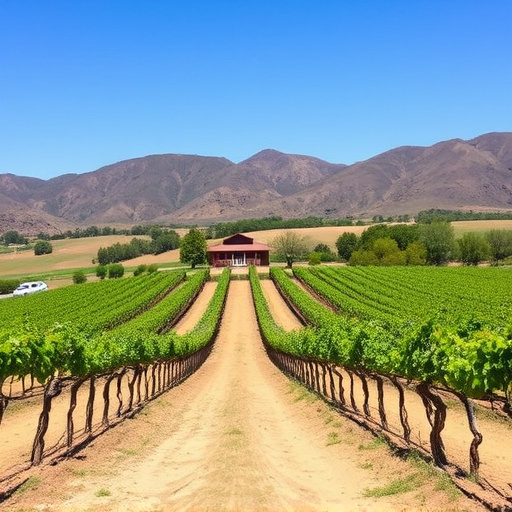Sonoita, AZ high-elevation vineyards (vineyards sonoita az) thrive due to cool temperatures and well-draining soils, resulting in unique grape varieties with complex flavors. Mountains and canyons create microclimates, fostering optimal conditions for premium vintages. These vineyards offer ideal ripening environments, leading to well-structured white wines and intricate red blends. The region's distinct terroir, influenced by elevation and terrain, sets its wines apart, making Sonoita a premier destination for wine enthusiasts seeking unique, elevation-driven experiences.
“Uncover the enchantment of high-elevation vineyards in Sonoita, Arizona, where the region’s unique terroir crafts exceptional wines. This article navigates the vibrant landscape of neighboring estates, delving into their distinct characteristics and the factors that set them apart. From aromatic allure to complex flavors, we explore specific wines from each vineyard, providing a sensory journey. Whether you’re a wine enthusiast or curious explorer, this guide offers insights and recommendations to enhance your experience when choosing the perfect high-elevation vineyard in Sonoita, AZ.”
- Choosing High-Elevation Vineyards in Sonoita, AZ
- – Discussion on the unique characteristics of high-elevation vineyards in the region
- – Factors to consider when comparing estates
Choosing High-Elevation Vineyards in Sonoita, AZ

Choosing High-Elevation Vineyards in Sonoita, AZ is a decision driven by both geography and viticulture. The region’s high elevations, often exceeding 4,000 feet, offer distinct advantages for winemaking. Cooler temperatures slow down ripening, allowing for slower sugar accumulation and the development of complex flavors in the grapes. This environment fosters a unique set of grape varieties that thrive in such conditions, contributing to the distinctive character of Sonoita wines.
When selecting vineyards in Sonoita, AZ, look for areas with well-draining soils, typically sandy or gravelly loams, which help prevent waterlogging and encourage deep root growth. The surrounding landscape also plays a role; mountains and canyons can influence air flow and temperature variation, creating microclimates that benefit diverse grape types. These factors combine to create optimal conditions for producing high-quality wines, making Sonoita a premier destination for wine enthusiasts exploring unique, elevation-driven vintages.
– Discussion on the unique characteristics of high-elevation vineyards in the region

The unique characteristics of high-elevation vineyards in Sonoita, Arizona, are a key factor distinguishing their wines from those produced at lower elevations. Located at elevations typically exceeding 3,000 feet, these vineyards benefit from cooler temperatures and longer growing seasons, resulting in slower ripening grapes that retain higher acidity levels. This balance between sugar and acid is crucial for crafting well-structured, refreshing white wines and complex red blends. The region’s vibrant microclimates, influenced by its high altitude and varied terrain, allow distinct grape varieties to thrive, contributing to the diverse and distinctive flavors found in Sonoita’s high-elevation wines.
Compared to their lower-altitude counterparts, these vineyards often face more dramatic diurnal temperature shifts, with warmer days and cooler nights. This temperature contrast helps preserve delicate aromas and flavors in the grapes, leading to wines that are known for their bright fruit notes, mineral qualities, and nuanced complexity. The challenging growing conditions also foster a strong sense of place, making each estate’s offerings a true reflection of the unique terroir of Sonoita, AZ, vineyards.
– Factors to consider when comparing estates

When comparing high elevation wines from neighboring Sonoita estates, several key factors come into play. First, vineyard location is paramount; the microclimates vary significantly even within short distances, affecting grape ripening and flavor profiles. Elevations in the 1200-2000 foot range are common in Sonoita, with each estate’s unique terrain contributing to distinct wine characteristics.
Second, soil composition plays a crucial role. The region’s diverse soils—from sandy loams to clay-rich volcanic deposits—bestow upon grapes distinctive mineral notes that translate into the final product. Third, grape varieties and viticultural practices specific to each estate further differentiate their wines. Understanding these aspects allows connoisseurs to appreciate the nuanced differences between high-elevation vineyards in Sonoita, Arizona.
When comparing high-elevation vineyards in Sonoita, AZ, it’s evident that each estate offers a unique microclimate and terroir. The factors to consider—such as elevation, sun exposure, soil types, and grape varieties—significantly impact the wine’s character. By delving into these distinctions, wine enthusiasts can fully appreciate the vibrant tapestry of flavors that each neighboring estate has to offer, making Sonoita a true destination for high-quality vineyard experiences.
